What equipment and materials are needed to create a water heated floor? Equipment for installing a warm water floor
Today, the installation of heated floors in the room has become very popular. One option is a warm water floor. There is a huge range of equipment for its installation on the building materials market. And to make the right choice is very difficult. Therefore, it is necessary to study the characteristics of each element and find out if there is a need for a structure such as a water floor at all.
Water-heated flooring is one of the most cost-effective and popular types of heating systems. The heating of the room takes place due to the circulation of hot water through a pipeline built into the floor.
a is a layered structureconsisting of:
- base layer (wooden floor or concrete slab);
- waterproofing;
- heat insulation (prevents heat from escaping from a given direction);
- water floordirectly heating the room;
- concrete screed;
- final coverage.
How to choose equipment
The main elements of this heating system are pipes and boiler. In addition, you may need a collector and a box for it, a pump, connecting pipes to the boiler, fittings, heat and waterproofing materials.
Pipes
Among can be used pipes from different materials:
- of stainless steel;
- copper;
- reinforced polyethylene;
- metal plastic etc.
Today produce pipes specifically designed for heated floors. They are very flexible, able to withstand high pressure. Their service life can reach 25-28 years.. But they are quite expensive. The best option is a pipe made of metal. They can last a long time, and install them simply. It is better to abandon polypropylene pipes, because they are not suitable for installation in a concrete screed. If you take a metallized, it is desirable with an antioxidant coating.
For each heating circuit, you need to take a separate pipe of suitable length. Connections in the middle of the system should not be. The optimal tube diameter is 2 cm.
How to replace the central heating system to a warm floor:
Collector
Collectors there are different kinds. The simplest models only allow coolant through the pipes, and no longer provide for other functions. More modern designs make it possible to regulate the flow of water to each individual branch of the system, to set its temperature. The newest versions are equipped with an auto-adjusting system, which itself sets the necessary parameters.
To choose a collector, you should focus on the number of circuits in the house (apartment), and on the need for constant control. If all rooms should have the same temperature level, you can do with a simple collector model, and not overpay for additional functions.
Thermal insulation
Before you install the pipe, you should make the insulation. Without heat loss during the operation of a heated floor is indispensable. The system will give some heat to the outside. Therefore, insulating elements are laid under the tubes. This will keep warm, accelerate the process of warming the room.
To choose a material for heat insulation, should be considered:
- heating power of the heating system;
- load bearing capacity of the floor;
- economy.
Materials for thermal insulation:
- penofol;
- polystyrene foam;
- corkwood;
- mineral wool.
For the device in a warm water floor, expanded polystyrene is better suited. A layer of it is made of at least 3 cm. In order to keep the heat in places of the joint, they are reinforced with a polymer web with a reinforcing mesh. Since expanded polystyrene is a flammable substance, it is additionally covered with a foil formulation.
Full review of equipment for warm water floors, see here:
Installation options
There are several methods for laying pipes for a water floor.:
- Snake - pipes are laid along the wall, at the end they are bent and directed to the other side. This covers the entire floor surface. The difficulty of this method of installation in the design of the bend tube. With small steps, the pipe bends very hard, and the large distance between the pipes does not properly heat the surface.
- Double snake - Unlike the previous method, 2 pipes are used here, running parallel to each other. The distance between them should not be more than 3 cm.
- Spiral (snail) - laying comes from the outer perimeter of the room moving to the center. From the center of the pipe is turned back, closing the circuit. This pattern of laying is very popular, because due to the alternation of hot and cooled tubes, a uniform heating over the entire surface is ensured.
- Combined method - in one room several pipe fittings are used. This is true if the room has a non-standard shape with protrusions or recesses, for example for installation.
Installation
Before you produce, you need to prepare the surface. It should be perfectly smooth. To do this, you can use self-leveling mixture to fill.
- A waterproofing material is placed on the rough surface.. At the joints, it is attached with scotch tape. Along the perimeter of the wall it is fixed with a damper tape.
- The next layer is heat insulation. The thickness of the material depends on the characteristics of the room. For example, in the basement or on the first floor, the density of thermal insulation should be high. This helps reduce heat loss. For the kitchen, a layer of ordinary foil will suffice.
- Next stage - pipe laying according to the chosen scheme. The average distance between them should be about 30 cm. They are fastened with plastic clamps to the reinforcing mesh, or special profiles. Insulators are produced with the protrusions already provided, with the help of which the pipes are fixed.
- Fittings connect tubes to the collector.
- The collector is connected to the system and run it in test mode. Pressure and temperature should be raised gradually over at least 4 hours. In the absence of leaks, test the maximum allowable pressure by pumping water through the pump into the system.
- After testing the construction of the pipe is covered with a reinforcing mesh. and poured cement screed not thinner than 3 cm. allows you to lay tiles directly on the screed.
- After drying the screed, stack. The humidity of the surface should be 2–4%.
Read how to lay linoleum in the kitchen.
Video tutorial installation of a warm water floor:
Errors of installation of a heat-insulated floor, do not allow them:
Installation of a warm water floor should be approached responsibly. The performance of the system depends on the quality of the equipment and installation, so choose an inflatable manufacturer, for example. To be sure in the work of a heated floor, it is better to entrust its installation and connection of the system to the collector to professionals.
Water heated floors is the way to create comfort and coziness in the room. Their production requires special attention. Especially it concerns the choice of the necessary equipment. It must meet modern quality standards, which will ensure good heating of the home. What you need to purchase components for a warm water floor? You will receive the answer to this question in this article.
What you need to buy
To create warm floors, the project is done first. According to this project, all the necessary equipment is being assembled. Among the main purchases should be the following components:
- Thermal insulation of different thickness.
- Pipes and fittings.
- Damping adhesive tape, thickness from 5 to 10 mm.
- Fasteners for pipes: anchor bracket, mounting plate, clamps for pipes, arc for turning pipes at a right angle and so on.
- Collector cabinet.
- Reinforcement mesh.
- Boiler.
- Material for pouring screed: sand, cement and plasticizer.
This is perhaps the main equipment that will be required to create floor heating. Now consider some categories in more detail.
Pipes and fittings

Only quality pipes can provide a good heated floor. Today you can buy plastic pipes or cross-linked polyethylene. This material is fully consistent with quality standards. They can be poured cement-sand screed.
Given the fact that the pipes will be poured with a coupler, special attention should be paid to their quality. Otherwise, it will be very difficult to remove them from the floor for repair.
It is forbidden to use pipes that are used for water supply wiring. Quality pipes must meet the following criteria:
- Tightness.
- Flexibility.
- Protection against diffusion of oxygen.
In order for a laid contour to serve as long as possible it should not consist of two or more pieces of pipe.
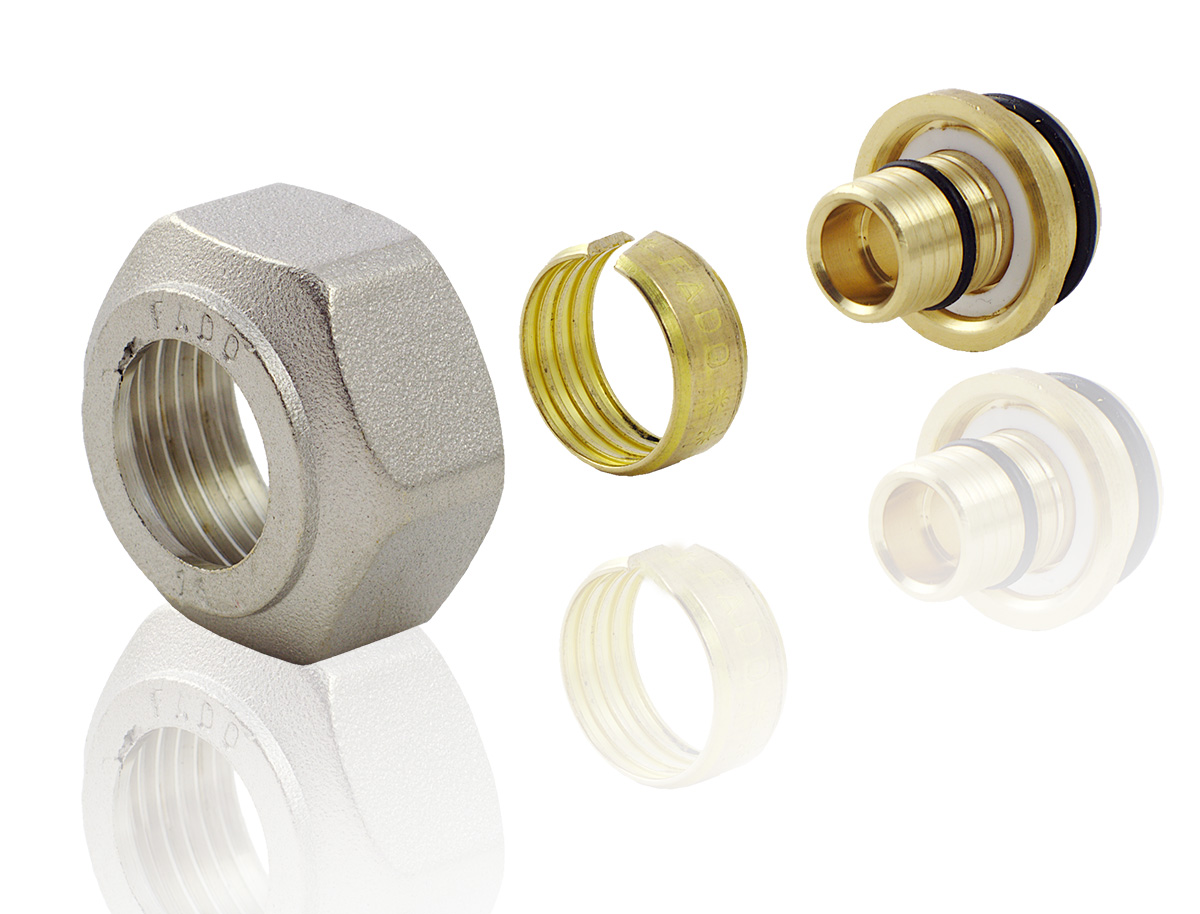
These requirements are also applied to all purchased fittings that connect the piping system in a manifold cabinet. In order not to get to the fake, the purchase of all such equipment is better to carry out proven suppliers.
Control system equipment
Each warm water floor is equipped with a control system. As a rule, it is located in the collector. Here should be the following equipment:
- Pump and mixing block. Through it control and adjustment of temperature is carried out. The control is carried out in a direct line of adding cold water.
- Collector with flow meters. This equipment evenly distributes coolant to the contours. It is desirable that it was made of stainless steel. For the convenience of monitoring the coolant flow rate, an individual upper counter is installed. In the existing viewing window you can monitor the flow of water.
- Nickel-plated ball valves.
- Collector cabinet. This is where the entire control system is located.
- Servo. The servo closes and opens the heating circuit, which is connected to the temperature controller. The thermostat is mounted in a heated room.
- Euroconus connections. They are intended for docking pipes with a collector.
These components for a warm water floor will create a reliable control system.
The key link in the system is the collector!

The main equipment of the entire floor heating system is the manifold. It can be purchased both in finished form and disassembled. Moreover, some decide to make it homemade. But for this it is important to understand the principle of its operation and choose only high-quality equipment. Additionally, the collectors are equipped with circulation pumps, pressure stabilizers, thermostats and the like. It has a different number of outputs for heating circuits. Each circuit is equipped with shut-off valves. This allows, if necessary, to block a certain section of heating.
Thermal insulation material
For underfloor heating, a thermal insulation layer is an important requirement. It fits under the pipes. Thickness may be around 50 mm.
There are many types of thermal insulation. For example, foil, polystyrene foam, mats, plates with waterproofing and the like.
Some use foam. But in this case, an additional layer of waterproofing film is required. It completely eliminates the appearance of condensate.
All the listed equipment in this article will allow you to create a complete heating floor system. We hope this material will help you in choosing and assembling the necessary components. We encourage you to leave comments on this article if you need other additional equipment.
Any questions?
There are several options for heating systems called "warm floor". Considering the fact that film and cable versions of products have the simplest installation system and are accompanied by minimal use of additional equipment, it is worthwhile to consider in detail exactly equipment for underfloor heating based on the use of liquid as a heat carrier, because it is much more complicated.
Water floor systems look like this: a pipeline is laid between the rough base and the floor topcoat, in which a heated thermal medium, a liquid, moves along a closed loop.
Note!With this method of heating, not only ordinary water, but also other types of liquids can be used, for example, ethylene glycol or antifreeze.
General form
The advantages of such systems are many:
- When compared with radiator-type heating systems, such heating saves about 12% of thermal energy.
- Maintaining comfortable for living person temperature. The temperature indicator at the floor level is 22-24 degrees Celsius, and around the head - 20.
- Due to the small difference between the temperature indicator of the state of the air and the floor, a low speed of movement of convective currents is ensured, as a result, the dust does not rise into the air.
- Provides uniform heating of the room, in which there are no overheating zones and cold areas.
- Efficiency of heating does not affect the state of the air, the optimum level of humidity is maintained, thanks to which the room creates the most optimal conditions for a person. No dampness or dry air.
- When the liquid circulation is turned off, the heated coolant will still give off heat for several hours, maintaining a favorable air temperature in the room.
- The term of the effective operational service of the pipeline laid during the arrangement of the system is about half a century.

Pipeline on the insulating layer
- There is no need to carry out special maintenance, since the equipment practically does not break during operation.
- In the process of using the system does not emit electromagnetic fields.
- The presence of water heated floor in the room does not impose any restrictions on the subsequent formation of the interior.
Water type flooring
There are several types of water flooring:
- Concrete type - requires the implementation of a concrete screed, which dries within three weeks. That is how long it takes concrete to fully cure. Due to all elements of the overall design, the height of the room with this method of installation is reduced by at least 10 cm.
- Floating type - in this embodiment, the pipes are simply covered with a special gasket that absorbs moisture. This gasket is made of polyethylene foam, sometimes for its production is used cardboard, covered with aluminum plates on top. The finishing coating, for example, parquet, tile, laminate, etc., is subsequently laid on these plates.

Installation on a polystyrene foam plate
- Wooden type - laying on wooden logs or wood floor.
The list of equipment necessary for arranging a water-heated floor system includes manifolds and fittings that are used to connect to a common heating system, as well as a pump that circulates coolant, polymer or metal-polymer pipes and thermal insulation on which they are laid. In addition, fasteners are used for fixing parts of the system.
Features of equipment for floors
The most important element of the system are the fittings and the pipeline. To warm floors served for a long time, and their operation was comfortable and trouble-free, you must install plastic pipes of high quality.
Note!Poor quality pipes can quickly become unusable, and to replace or repair them will require breaking the entire concrete floor. It is unacceptable to use products that are designed for hot and cold water.
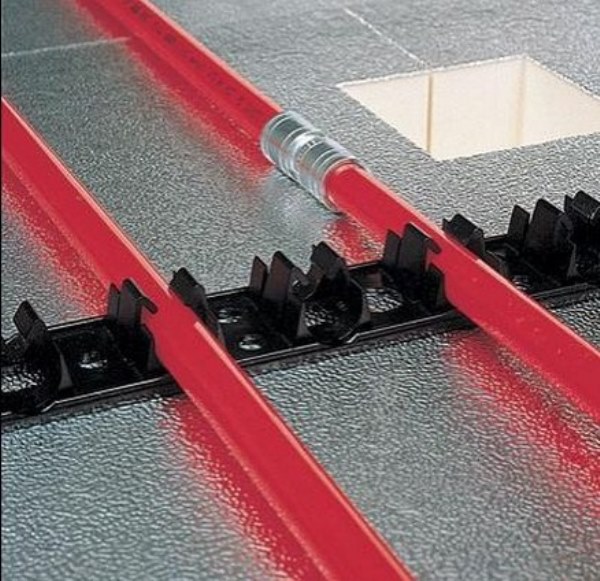
Another way to fix pipes
Quality the pipe has the following properties:
- 100% tightness;
- flexibility to bend the product manually;
- special protective layer that will create an obstacle for the development of oxygen diffusion;
- wholeness;
- the operational period must be commensurate with the useful life of the building.
Most often pipes from plastic or metalplastic are used. The optimum diameter of the products is 1.6-2 cm. The distance in the coil should be at least 10 cm and not more than 30 cm. It is very important that the pipeline is not threatened with corrosion damage, and their internal diameter must be maintained throughout the entire service life. pipes.

Ball valve
Various materials are used for thermal insulation. As a rule, it is polyfoam and its other derivatives (extruded or extruded polystyrene foam). The thickness of the insulation standing should exceed 2.2 cm. If the room is poorly heated or there is a dirt floor, then the minimum figure is 3 cm. In order to avoid a thermal bridge between the heating plate and the wall, a thin foam sheet is laid in this area. You can use a damper tape.
In order to ensure uninterrupted operation, the floor heating system in addition to the pipeline and related materials, is equipped with additional equipment.
Such equipment includes:
- ball valve, which comes bundled with several;
- collector equipped with flow meters;
- connecting element - "euroconus";
- servo;
- collector cabinet;
- unit that acts as a pump and mixer.

Collector block
The collector, which has adjustable flow meters, is designed to distribute the heat carrier over all elements of a closed loop - the pipeline. For the production of this part is used stainless steel. Each heating circuit has an upper meter, which is located on the supply line. Thanks to this, the consumer can regulate the flow of water without using any tools at all. A viewing window allows you to control the amount of fluid consumed.
The package of ball valves includes a pair of balls coated with a layer of nickel-plated material. The servo drive closes and opens the heating circuit. This drive is connected to a thermostat installed in a room that is heated.
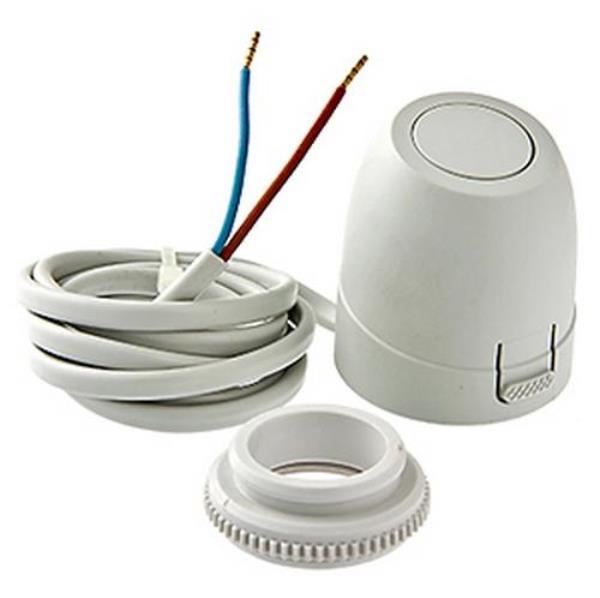
Servo
Euroconus is used to connect the pipeline with the collector. A pump and mixing unit allows you to regulate the temperature on a straight line. This control is carried out by adding water to the system, which comes from the return pipe.
A manifold belonging to the heating circuit is placed in the collector cabinet. Here is the central hub, due to which the temperature indicators in individual rooms are regulated.

Euroconus
In order for the system of warm water floors to fully function, it must be provided with an energy source, preferably of an autonomous type, which will be heated by water. Most often in such cases gas boilers are used. Due to their effectiveness, the result is substantial cash savings. And if you use a type of condensing boilers, they can reduce consumption by about 35%. Therefore, the equipment used to install underfloor heating quickly pays for itself.
The quality of heating has ceased to depend on utilities. Many homeowners are upgrading standard heating schemes. One of the types of such heating in the house is a warm floor. It can be electric and water.
Electric underfloor heating has a working principle suitable for heating small rooms: baths, toilets, kitchens and hallways.

The water floor is designed for heating residential and public buildings with an area of more than 20 m 2. For smooth operation, you need high-quality equipment for underfloor heating, selected according to the exact calculation for a particular room.

The article will discuss the equipment for water heated floors of different types and the design features of each of them.
Water floor heating is a system of circular circulation of hot water through pipes laid in the floor. Through them, the heat is transferred to the cement-sand screed, and from it spreads throughout the room. The water floor is connected to the central heating system or gas boiler. This method of heating has its pros and cons.
Pros:
- It is used as the main method of heating. Efficiency measurements showed that the efficiency of the floor heating is 12-14% higher than that of radiator heating.
- Heat is evenly distributed throughout the room. At a level of 20-30 cm from the floor, the temperature is 22-24 ° C. At an altitude of 200-240 cm - 20 ° C.
- Low air convection speed. Due to this dust practically does not rise from the floor.
- Heating eliminates the appearance of "dead zones", where the heat from the heating elements does not reach.
- The content of water vapor is always in the normal range. Water floor does not dry out the air. At the same time, it does not allow strong moisture to appear.
- Water floor heating accumulates some of the energy. When the heating is turned off, the room will not freeze for several hours.
- Polypropylene pipes do not rot. The term of their trouble-free service is 30-50 years.
- Such a floor does not create an electromagnetic field around.
- In the design and creation of design water heated floor does not interfere. All elements are hidden under the sand and cement screed.
Minuses:
- Initial costs for the purchase of materials and installation are higher than when using electric heating elements.
- It works as a single system. Replace a separate section of a leaky pipe will not work. It is necessary to dismantle all the pipes for replacement.
- High labor and financial costs of installation. Long installation time.
- Thermal load per 1 m 2 of area is lower than with electric heating.
Floor types
There are three water heating systems for residential premises:
- Classical - heating elements from polypropylene pipes through which hot water circulates. They are mounted in a concrete base floor.
- Electro-water - heating fluid circulates through the pipes, which are laid electrical cable. The pipes are recessed into the concrete floor.
- Floating - polypropylene pipes with hot water. They are stacked in prefabricated wooden or plastic blocks.
Classic
A common method of heating residential and public buildings. The heating medium is heated from the boiler or comes from the central heating system.

Classic water floor is a universal system that can be connected to any heating plant. This can be done both during the construction of the facility, and after its completion.
Design features:
- Such a floor can be installed in a private house or public building.
- In high-rise buildings, the installation of a water floor is associated with a high risk of lowering pressure in the general house system and disrupting the hydraulic integrity of the heat transfer media.
- Heat energy comes from the bottom and is evenly distributed over the entire area of the room. Wooden furnishings will not crack.
- The floor consists of plastic pipes that do not corrode. This makes the design reliable for many years of operation.
Classic warm floor mounted in two ways:
- The first. The pipes are poured with concrete or cement-sand screed. In this case, the stone base acts as a shield for heat distribution. Installation of additional elements is not required.
- Second. Pipes are placed in plastic cassettes. Each has a groove framed with an aluminum heat-reflecting plate. Polypropylene pipes are inserted into the gutters and covered on top with sheet material such as GVL or OSB.
The classical system has a number of advantages and disadvantages.
Benefits:
- Suitable for all types of modern flooring.
- Installation is done by hand in a short time.
- It can be connected to any autonomous heating system.
Important! Before connecting, it is necessary to perform a thermal calculation. The water floor should smoothly fit into the general heating cycle without overloading it.
- The classic system can completely replace electric and radiator heating. The main thing - to make additional door insulation and sealing windows. This will reduce heat loss through the enclosing structures. Energy savings is 25-30%.
The disadvantage is that the system is not recommended to be installed in apartments of high-rise buildings. Any emergency situation will lead to disconnection from the heat of the entire entrance and flooding of several lower floors.
Electrically heated water floor
This is a block system consisting of pipes with a heating element. Instead of water, a special liquid is used.
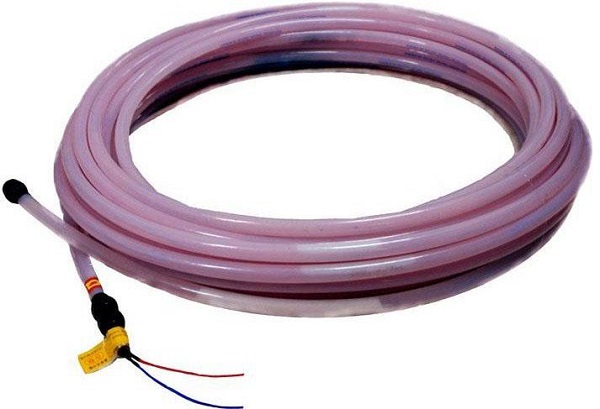
Design features:
- An autonomous heated water floor does not need to be connected to a boiler. The fluid heats up with a cable. It does not circulate through the pipes, so do not connect pumps.
- The floor is sold in prefabricated units consisting of a base, polypropylene pipes with electrical cable and heat transfer fluids.
- It works from the network. Do not do a test run. It is enough to plug the plug into the outlet.
- Electric floor heating is equipped with temperature control sensors. Therefore, the system does not overheat, and the same temperature is maintained in the room.
Benefits:
- To heat the room you need a small amount of liquid.
- The floor surface is heated uniformly, unlike water, where air traffic jams periodically appear in the pipes.
- There is a possibility of zonal installation of heating circuits. This means that within the same room there can be several independent heating zones.
- The system can be installed in high-rise buildings.
As a drawback - energy costs significantly exceed the performance of classic water heating.
Flooring system
This is water floor heating when pipes are laid in wooden or plastic trays. From above they are covered with shields from GVL.
- The wooden system is popular. Pipes are laid on a wooden base. Aluminum heat-reflecting plates are installed around them. There are modular structures, where the floor is assembled from ready-made modules.

- The polystyrene system works on the same principle as wood. As a base, use polystyrene plates with grooves for pipes or bosses.

Benefits:
- The thickness of flat water floors is less than other types.
- The weight of the structure allows it to be installed even in old wooden houses.
- It takes less time to warm up than classic water floors.
The disadvantage is that it cannot work the way the main heating works. This is due to the low power of the heating elements.
Project for the floor
There are clear boundaries when the design of a heated underfloor heating should be carried out, and when not. If it is not the main source of heating, and the area of the room does not exceed 20 m 2, then it is not necessary to order the project.
When the water floor is planned as the only source of heating, and the area of the room exceeds 20 m 2, the design of a water heated floor is carried out without fail. The project is needed for several reasons:
- For commissioning of the facility where the heated floor is mounted, project documentation is required. A simple calculation on a piece of paper will not work. The documentation indicates all design loads on the heating system.
- For the conclusion of a formal contract for the installation of a water heated floor will require project documentation. Otherwise, it will be difficult to prove a marriage.
- Without project documentation, costs for work and materials are rising. Accurate data is not, all volumes are determined by eye.
On the installation plan for pipes and accessories, all dimensions and materials should be indicated.
Equipment and materials
Despite the design features of different types of water floor heating, the main components are the same:
- Pipes and fittings. This is the basis of everything. As a rule, pipes are laid in concrete. Their lifespan should coincide with the life cycle of the building. Any leakage leads to the dismantling of the entire coating. Conventional plumbing pipes are not suitable. For water floor use elastic and sealed plastic and metal pipes with a diameter of 16-20 mm. They should not rust and collapse due to oxygen diffusion. The inner surface should be finely porous so as not to trap the algae and other microorganisms.
- Heat insulation materials. This is basalt mineral wool and extruded polystyrene foam. Sheet thickness not less than 30 mm. They must be durable, withstand mechanical loads from furniture and people.
- Damper tape. This is a polymeric material that is glued around the perimeter of the room. The tape dampens changes in the size of the floor from temperature fluctuations and warms the corners.
- Collectors. These systems automatically regulate the water flow and its temperature. They are equipped with sensors to determine the temperature, pressure and flow rate of water in the system.

- Collector cabinet. It installs basic equipment to ensure the work of the water floor. Shut-off valves, heat meters and water consumption are all installed in it. Collector cabinet can be hung on the wall or installed on the floor. It is also equipped with a door with an internal lock. This is protection from strangers and children. The cabinet must be covered with a layer of polymer that will protect it from corrosion. On the door there is a viewing window to control the main parameters of the devices.
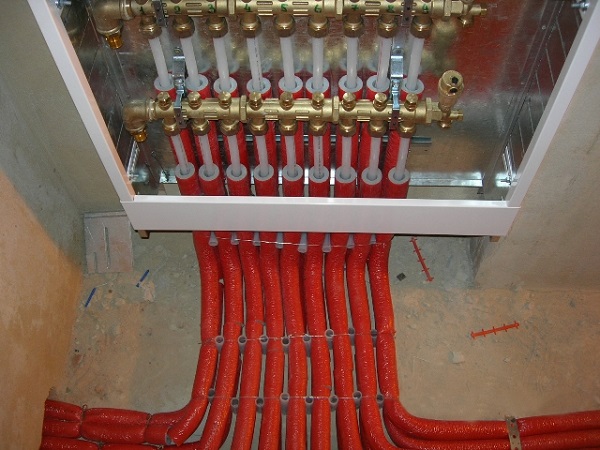
- Mixing node In it, the liquid is mixed to the desired temperature. It is equipped with temperature and pressure sensors. A shut-off valve is installed on it to adjust the hot and cold water.
- Control system. It can be installed in any convenient place. It consists of a panel with buttons that can adjust the temperature. Modern systems are equipped with remote control panels or even the function of working through the Internet.
A good option is polypropylene pipes from Western European or Scandinavian manufacturers.
- To supply water, you must use seamless, durable and flexible pipes. Any additional connection is a leak.
- Extruded polystyrene insulation is the best option. It has the lowest coefficient of heat conductivity and water absorption.
- Pipes "play" when heated and cooled. For their attachment it is better to use elastic wire.
- For valves better fit ball valves.
Video
Underfloor heating is an easy way to create a comfortable living environment at a reasonable cost. If you follow all the rules and recommendations, then problems with operation will not arise.
It is considered that the warm floor is a modern heating system. At the very least, such a statement is a delusion and a historical mistake, since floor heating systems have been known since the times of the Roman Empire and were actively used to heat the Roman baths, which are called terms. Then the pipeline was supplied with hot smoke, which was the main coolant. Today, a warm water floor is used for the system with several heat transfer fluids, in particular, antifreeze, ethylene glycol solution or simply water.
Why for so many years such heating has not only not lost its relevance, but also received a number of improvements and unlimited trust and popularity among homeowners? Of course, all this is due to the numerous positive characteristics.
Let us dwell in more detail on the advantages of a warm water floor.

The comfort of such a heating system has already been mentioned many times. However, the majority of purchasers are always interested in the question of the efficiency of such heating, so the occasion should be said that in comparison with the radiator system, heat saving is about 12%, regardless of the floor space. The total absence of convection currents ensures the complete absence of dust in the air, which is a significant advantage in comparison with the radiator heating system. We can not say about the creation of optimal humidity, which affects not only the physical well-being of the residents, but also the appearance of fungus or mold on the decorative floor covering. The special advantage of a warm water floor is the ability to accumulate heat and then gradually release it over several hours, thus maintaining the optimum temperature in the room. An important circumstance is that such a heating system does not require maintenance and has a sufficiently long service life. It is necessary to note the fact of the absence of electromagnetic radiation, which creates an electric or infrared floor, which makes the water heated floor system absolutely safe and environmentally friendly for human health.
So, what equipment should be purchased to install such a heating system.
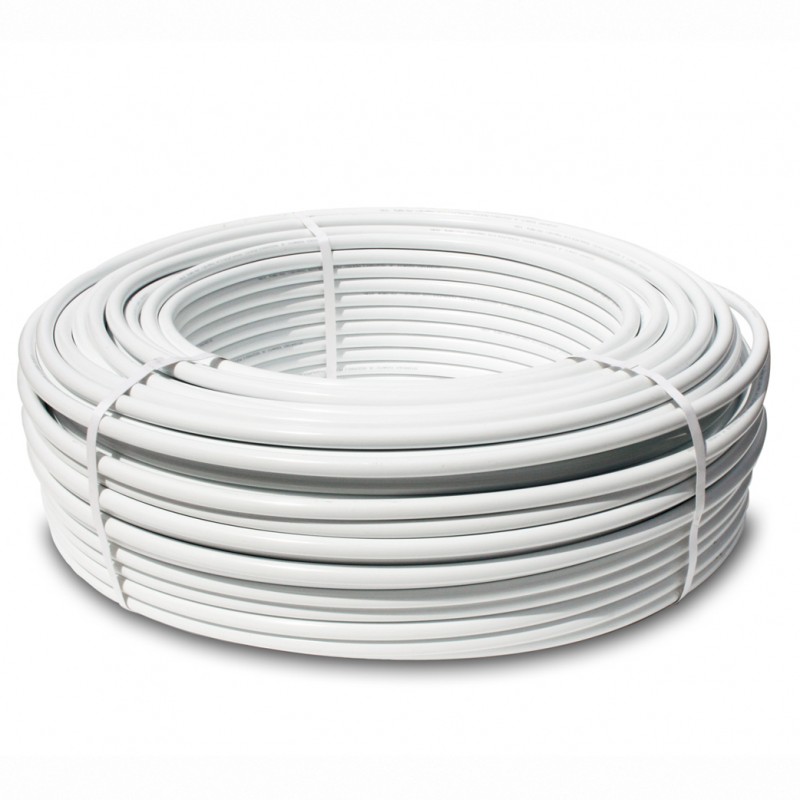
Here is the actual list of necessary equipment for a water heated floor.
Be sure to look at two very useful and interesting video clips about the device of a water heated floor and the equipment used for its operation:
